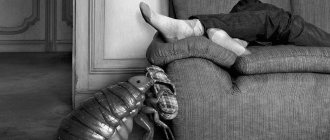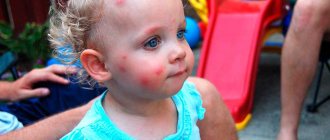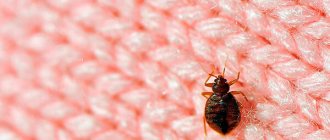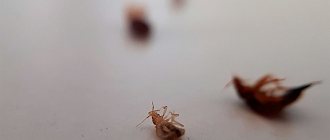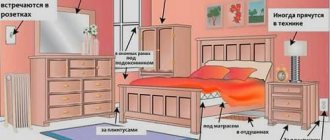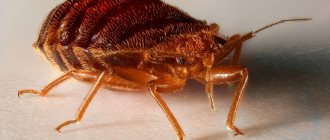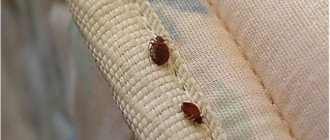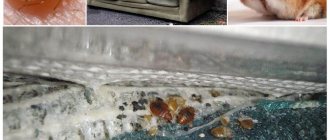Next you will learn:
- What do bedbugs eat and is blood really their only source of food?
- How long can bed bugs live without bleeding and will they die if they leave the apartment for several months?
- Do bedbugs bite domestic animals (cats, dogs) and why chicken coops are sometimes simply infested with these parasites;
- You will also find out whether bed bugs live in the wild and whether you can accidentally pick them up somewhere...
Bedbug bites are a kind of paradox of modern civilization. These parasites, which plagued people back in stone caves, today easily adapt to the conditions of apartments with European-quality renovation and continue to reproduce successfully, despite all the achievements of the chemical industry producing insecticidal preparations.
A huge number of apartments and houses in Russia, the USA, Great Britain, China, in developed and developing countries are simply infested with bedbugs (the problem is especially acute in small hostels, through which a significant flow of people of middle and low income passes).
But why are these bloodsuckers so difficult to fight? After all, it would seem that bed bugs feed on human blood, which means it’s enough to leave the apartment for a couple of weeks, and that’s it! The parasites will die, so to speak, of starvation - simply for lack of a food source.
However, practice shows that even if you leave a room infested with bedbugs for six months, often not the entire population of parasites dies: the surviving individuals begin to bite people again and actively reproduce.
But how does this happen? What have the bugs been eating all these months, and do they really only feed on human blood? Are they going into suspended animation? Let's figure it out together...
Diet and feeding method of bed bugs
The bedbug's only food is really the blood of mammals. Like other types of bedbugs (and there are more than 40,000 species in nature), the jaws of apartment parasites have turned into an elongated proboscis, with which the insect pierces human skin, reaches a blood vessel and sucks blood until it is saturated.
This is interesting
Generally speaking, what bed bugs feed on is clearly visible through the translucent walls of their young larvae: their bodies appear scarlet from drinking blood (see examples in the photos below).
If you catch several insects of varying degrees of saturation, it is easy to notice that hungry adults have a flat brown body, and hungry larvae are light brown or light yellow. When saturated, the parasites turn dark scarlet, their bodies swell, filling with fresh blood.
At the same time, blood-sucking bugs are quite original in their “dining habits.” For example, they are not satisfied with sucking blood from only one wound during one feeding. In most cases, they make several punctures along one blood vessel (or even without reference to it).
Thanks to this feature, bed bug bites stand out noticeably from the bites of other human parasites: their traces are usually connected in chains with an interval of 1-2 centimeters. A kind of tracks of bites are formed (so if you find such tracks on your body, then you should not attribute them to allergies, as unprepared people often do when they first “get acquainted” with bedbugs).
See also our experiments on bedbugs:
We catch bedbugs and test different products against them - see the results...
- We test the effect of Hector powder on bedbugs in two options: simple treatment and preparation of traps. See the results of the experiment.
Experiment on bedbugs: at what temperature do they die and how it can be used in practiceWe put the bedbugs in a container that was treated with the Executioner product a week ago - we’ll see if the parasites are poisoned by the long-dried product...
- We tested the Get Express product on bedbugs - let's see what came out of it...
Experiment on bedbugs: The executioner killed them in 8 minutes
We check the residual effect of the Executioner on bedbugs (how quickly they are poisoned upon contact with a previously treated but already dried surface)
- Proven methods of killing bedbugs that have shown to be highly effective
In addition, bed bugs only bite hairless parts of the body. Because of their wide, flat abdomen, it is difficult for these blood-sucking parasites to break through the hairline to the human skin, so they almost never bite the head and groin area.
On a note
Common places for bedbug bites are the buttocks, thighs, sides, stomach, back, arms, neck and face. If a person sleeps in underwear, the parasites do not crawl under it and only bite exposed parts of the body.
The bug is a nocturnal bloodsucker. He prefers to attack his prey between two o'clock in the morning and five in the morning, when the person is most soundly asleep. The bites are practically painless, but the saliva secreted by the parasite, some time after entering the skin tissue, begins to cause itching. Accordingly, it is usually possible to catch the parasite directly at the moment of the bite only during light sleep or during an accidental awakening at night.
It is also useful to read: Furniture bugs (aka bedbugs)
And one more thing: Rating of bedbug repellents: choosing the best option
A characteristic feature is that after the bloodsuckers feed at night, small bloody spots often remain on the white sheet.
This is interesting
Other types of bugs living in nature can pierce the stems and fruits of plants, sucking their juices. Some attack arthropods, and large bugs even attack fish and frogs, sucking out almost all the insides of their victims. However, most bedbugs are vegetarians and do not attack humans.
Bed bugs today live almost exclusively in or near human habitation, and in nature they are found only in very specific places - for example, in bat nests.
Detection methods in the house
Bed bugs can hide in different parts of the house. For example:
- in sockets;
- behind the paintings;
- in the mattress;
- in sofa upholstery;
- behind wallpaper that has come off the wall;
- between furniture and wall;
- in a clothes closet;
- under the baseboard;
- under the windowsill;
- under the carpet;
- inside household appliances.
There are several clear signs of arthropods in the home. More details about this are in the table.
Table - Signs of a house turning into a bug infestation
| Sign | Details |
| Characteristic smell | — It smells like cognac, sometimes sour fruit; - the nest emits the smell of almonds |
| Bites | — Red dots appear on the body; — there are up to 7 bites in one chain |
| Blood stains | - Small blood stains are found on the bed linen; — traces remain from arthropods crushed in sleep |
During the day, insects do not leave their shelters; they hunt exclusively at night. If you get up at 3:00 am and suddenly turn on the light in the room, you can see a whole “swarm” of insects in motion. This cannot be confused with anything: neither fleas, nor cockroaches, nor ants are so active.
How long can bedbugs live without bleeding?
In general, we can say that bedbugs live for a long time without food. One or two months of hunger strikes are practically harmless for them and do not even require falling into torpor or any inhibition of physiological processes.
If there is no food source near the blood-sucking bug for too long, then it can fall into a state similar to suspended animation, in which the biochemical processes in its body are greatly slowed down. An insect can spend up to a year in this kind of hibernation, remaining alive.
There are known cases where apartment residents wrapped bedbug-infested mattresses with plastic wrap in the hope that the parasites would have nothing to eat and would die without blood in a couple of months. However, even after keeping the mattress wrapped in film for six months, the bedbugs were still alive in it.
On a note
In comfortable living conditions, the lifespan of a bed bug is about 12-14 months. If hibernation is present in the life cycle, then this period increases.
It is useful to consider the following nuances:
- adult bedbugs live longer without food than larvae;
- without receiving fresh blood, the female cannot lay another batch of eggs, so the reproduction of parasites practically stops;
- Without receiving blood, the larva is not able to molt, and its development slows down sharply.
This is interesting
Normally, a bedbug feeds every 5-6 days, and in between this, it digests the blood it drinks. Larvae may feed more frequently, but at each feeding they bite fewer times and suck less blood than adults.
Even if several dozen bedbugs live in a house, a person may not pay attention to their bites for a long time. Often, parasites bite only one person in the family, practically not touching the rest of the residents.
Review:
“We recently rented an apartment, unfurnished. We bought all new furniture and renovated it. After about a month, I began to find bite marks on the child. At first I thought it was an allergy, because my husband and I had nothing at all. Then I found bedbugs right in the children’s bed. Where did they come from? The apartment stood empty for a whole year; no one lived in it. The neighbors look at me like I’m crazy, they say that everything is clean with them...”
Marina, Moscow
It is also useful to read: Bedbug eggs and their destruction
And one more thing: you can kill bedbugs in different ways. You can use dummy products for six months, or you can initially kill the bloodsuckers with proven means and methods...
Bedbug development cycle
Mating occurs through traumatic insemination. A peculiarity of bedbugs is the ability to “postpone fertilization until later” in case of prolonged starvation. This increases the chances of survival. Bed bugs live on average from a year to 14 months. During a period of prolonged starvation, a sharp decrease in ambient temperature, bedbugs can hibernate - suspended animation. During this period, life processes slow down while maintaining the viability of bedbugs. In its development, a bed bug passes through the larval stage. The full development cycle of a bedbug from egg to imago - an adult individual - takes place in a month and a half. The growth process of bedbugs is accompanied by molting. To move to the “next age group,” the larva must drink a certain portion of blood. This is followed by molting. Unfavorable conditions prolong the cycle of imago formation to two to three months. Over the course of their entire life, females lay up to five hundred eggs, and 5 eggs per day.
Can bedbugs suck the blood of pets?
It is generally accepted that bed bugs do not bite domestic animals: cats, dogs, as well as guinea pigs, rats, etc. However, in reality it is not so simple.
In certain situations (critical for survival, that is, when there is no other food at all), blood-sucking bugs can also bite domestic animals. It is important that all mammals and birds are potential victims for bedbugs: parasites can, if necessary, feed on the blood of pigeons in attics and the blood of rats in basements.
However, it is much more difficult for bloodsuckers to feed even on rats than on humans - the presence of dense fur creates difficulties for access to the surface of the skin. There is no need to talk about dogs and cats here - due to difficulties with access to the skin, bedbugs practically do not touch these animals.
Even if people do not live in the apartment for a long time, but there are pets, the parasites gradually leave the room, if possible (usually through cracks and ventilation ducts - into neighboring apartments).
The “tidbit” for bedbugs is domestic chickens, with their thin skin and areas without feathers in the eye and beak areas. This is why chicken coops become infested very often: bed bugs feed on the blood of birds with the same pleasure as they feed on human blood. Often in rural areas it is necessary to poison chicken coops from bedbugs even more often than residential buildings - bedbugs here multiply rapidly.
Bed bugs and their diet in nature
In general, the number of bed bugs living in nature today is significantly less than the total number of their residential populations.
Sometimes wild populations of bed bugs are found in caves that maintain approximately the same temperature all year round: the parasites here feed on the blood of bats. Chiropterans have no hair on their wings, and under the thin skin there are easily accessible blood vessels, which provides the bugs with almost ideal conditions for feeding.
In some places in nature, bedbugs constantly live in the burrows of rodents and the nests of colonial birds. But these, one might say, are fragments of their main population.
This is interesting
Scientists believe that it was in caves in prehistoric times that bugs first tasted human blood and switched to feeding on it. Since then, these parasites have become constant companions of humans, and their populations in caves are considered to be kind of conserved.
Today, in addition to bed bugs, some species of predatory bugs parasitize bats. In the video below you can see how such a meal occurs.
